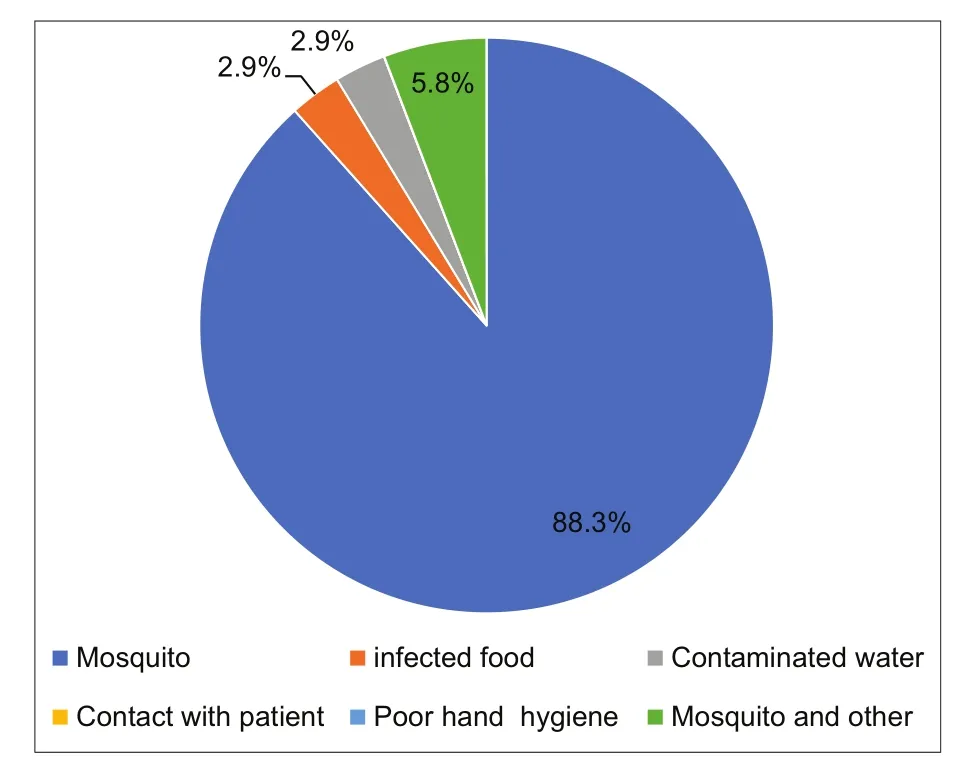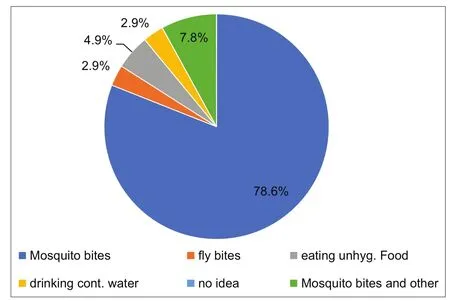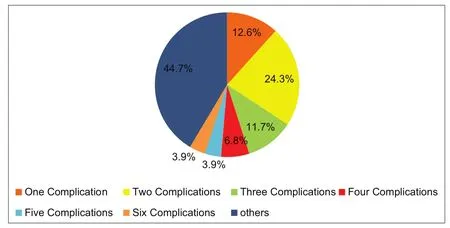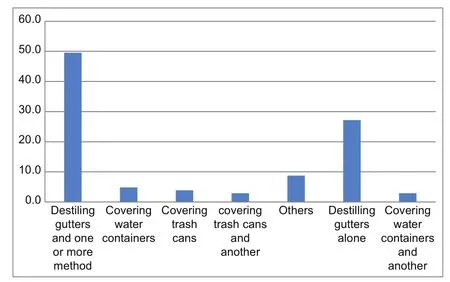Knowledge on malaria among caregivers with children aged under 5 years at Kenyasi Health Center
2021-12-30CeciliaAckonANSONGFrankBediakoAGYEIRamatuAGAMBIREJonathanBAYUO
Cecilia Ackon ANSONG, Frank Bediako AGYEI,Ramatu AGAMBIRE, Jonathan BAYUO
1Department of Nursing, Garden City University College,Kenyasi, Ghana; 2Department of Nursing and Midwifery,Presbyterian University College, Abete fi, Ghana
ABSTRACT
Background: Malaria remains one of the leading causes of morbidity and mortality among children under 5 years old in many low- and middle-income countries.According to the Ghana National Malaria Control Program, malaria kills at least three children every day and also tops the outpatient department cases in Ghana.
Objective: The present study sought to determine the knowledge of malaria among caregivers of children under 5 years at Kenyasi Health Center, Ghana.
Materials and Methods: The study was a descriptive, cross-sectional study.One hundred and three caregivers with children under 5 years old were recruited using the systematic random sampling technique, and data were collected using a structured questionnaire.
Results: The findings revealed that majority (98%) of the respondents knew at least one cause of malaria.Furthermore, all respondents knew at least one complication of malaria and majority (97%) knew at least one preventive measure of malaria.
Conclusion: Caregivers of children have adequate knowledge about malaria and its mode of transmission.Further education on the implementation of the preventive methods is still needed to help reduce the incidence of malaria among children.
Keywords: Caregivers, knowledge, Malaria, prevention
INTRODUCTION
Malaria is a life-threatening parasitic disease transmitted by female anopheles mosquitoes.Malaria is a highly prevalent tropical disease, with high morbidity, mortality, and high economic and social impact.[1]It remains one of the leading causes of morbidity and mortality among children under 5 years old in many low- and middle-income countries.[2-5]As of December 2015, it accounted for 214 million cases and 438,000 deaths globally with sub-Saharan Africa accounting for 88% and 90% of cases and deaths, respectively.[6]According to the latest World malaria report, released in December 2019, there were 228 million cases of malaria in 2018 compared to 231 million cases in 2017.The estimated number of malaria deaths stood at 405,000 in 2018,compared with 416 000 deaths in 2017.[7]Children aged under 5 years are the most vulnerable group affected by malaria;in 2018, they accounted for 67% (272,000) of all malaria deaths worldwide.[7]Despite reported decline in infestation and mortality, malaria remains the fourth leading cause of under-five mortality in the African sub-region.[8]
According to the Ghana National Malaria Control Program,malaria kills at least 3 children every day and also tops outpatient department visits in Ghana.[9]Malaria burden exerts a negative impact on economic productivity due to the human development and financial burden on the economy overall and on the affected households specifically.[10]
Disease prevention is of prime importance in reducing the rates of morbidity and mortality, but its everyday practice in households is related to local perceptions of risk and knowledge about malaria.[11]Since adequate knowledge about malaria is vital to guarantee that preventive measures are correctly applied and disease exposure reduced, this study sought to determine the knowledge of caregivers of children aged under 5 years on malaria.Although other studies have been done on malaria, no known research has been conducted among caregivers of children under five in Kenyasi.
MATERIALS AND METHODS
Study design
The descriptive, cross-sectional design was used in the research as it determines and reports the issues the way they are.It involves collecting the data to answer research questions on the current status of the subject of the study.The design helped in determining knowledge on malaria among caregivers with children aged under 5 years.
Participants
All caregivers (both biological and legal guardians) with children under 5 years old who visited the health facility,consented to participate in the study and were willing to participate during data collection were eligible for the study.The exclusion criteria were all caregivers with children above 5 years and caregivers with children below 5 years who were not willing to participate or were not present during data collection.
Sampling technique and sample size
Using the Raosoft online sample size calculator (http://www.raosoft.com/samplesize.html), the recommended minimum sample of 103 respondents was calculated at 95% confidence level, 5% margin of error, and a response distribution of 50%.
Data collection
A structured questionnaire comprising of open- and closed-ended questions was used in obtaining the data from respondents.The questionnaire was developed in English by the authors and translated into the local language (Twi)by two personnels who are fluent in English and Twi and then administered through face to face interviews after consent were obtained from the respondents.Pretesting of the questionnaire was done the week before to assess practicability and respondent’s understanding of the questionnaire.
Data analysis
Data were analyzed using the SPSS software version 20(Chicago, IL, USA).The findings were presented in the form of pie charts to depict a graphical representation on the sociodemographic characteristics of respondents such as age, level of education, and occupation and the knowledge level of malaria among caregivers.
Ethical considerations
Ethical clearance was sought from Kenyasi Health Center.The purpose of the study was explained to the respondents.Privacy and confidentiality were ensured as respondents remained anonymous in their response to the questionnaire.Participation was voluntary and optional.
RESULTS
Demographic characteristics
From Table 1, 36 (35%) of the respondents were within the age of 15-25 years and 21 (20.4%) were 36 years and above.Ninety-eight (95.1%) were female and only 5 (4.9%)of them were males.Considering the marital status of respondents, 65 (63.1%) were married, 3 (2.9%) were divorced,13 (12.6%) were cohabiting, 21 (20.4%) were single, and only one (1%) of the respondents was a widow.About 73 (71%)respondents were gainfully employed, whereas 31 (30.1%)were unemployed.Occupations of respondents varied from trading to professionals in various fields.
Knowledge on causes of malaria
Knowledge about cause and breeding site of malaria was assessed.From Figure 1, majority 91 (88.3%) of the respondents said mosquito bites, 3 (2.9%) said the intake of infected food, 3 (2.9%) said drinking contaminated water,and 6 (5.8%) said factors such as exposure to heat as causes of malaria.

Figure 1: Knowledge on causes of malaria
Knowledge on the transmission of malaria
Regarding the assessment on the knowledge about the transmission of malaria among respondents, 81 (78.6%) of the respondents believed that malaria is transmitted through mosquito bites, 3 (2.9%) believed that malaria is transmitted through fly bites, 5 (4.9%) believed it is transmitted through the intake of unhygienic food, 3 (2.9%) believed its transmitted through drinking contaminated water, 8 (7.8%) believed itstransmitted through other means such as exposure to heat.However, none believed that poor hand hygiene and contact with an infected person were the modes of transmission of malaria [Figure 2].

Table 1: Background characteristics of respondents (n=103)

Figure 2: Knowledge on transmission of malaria
On assessment of respondents knowledge on complications of malaria, as shown in Figure 3, 46 (44.7%) said other complications of malaria such as miscarriage and recurrent infections, 13 (12.6%) said one complication of malaria,25 (24.3%) said two complications, 12 (11.7%) said three complications, 7 (6.8%) said four complications, 4 (3.9%)said five complications, and 4 (3.9%) said six complications of malaria.
由于该项目大多属于流程再造、管理创新方面的内容,改变了传统的操作习惯,推行时使用者的抵触情绪很大。为了解决协调问题,保障信息系统的顺利实施,一方面,医院专门成立了由院领导带队的项目管理小组,实施期间定期召开院领导参加的项目协调会,具体安排各部门工作任务和计划;另一方面,医院做了大量宣传教育及培训工作。宣传教育工作由业务管理科室负责进行,主要是讲明政策要求及奖惩措施,通过优惠政策鼓励先行先试。通过培训和试用,让使用者感受到该项目的便利性和优越性,打消抵触情绪,半年后无纸化项目顺利启航。
Knowledge on the prevention of malaria
With regard to respondents’ knowledge on the prevention of malaria, 2 (1.9%) said the use of insecticide spray alone,2 (1.9%) said cleaning the house alone, 1 (1.0%) said other preventive measures such as handwashing and the intake of hygienic food, 5 (4.9%) said the drainage of stagnant water only, 30 (29.1%) said the drainage of stagnant water and other measures such as the use of mosquito coil, use of insecticide treated net (ITN), cleaning the house and the use of insecticide spray, 1 (1.0%) said the intake of antimalaria drugs, 62 (60.2%) said sleeping under insecticide treated bed nets and other methods such as use of mosquito coil,cleaning the house and the use of insecticide spray are the preventive measures of malaria [Figure 4].

Figure 3: Knowledge on complications of malaria

Figure 4: Knowledge on the prevention of malaria
When asked how to deal with or get rid off breeding sites of mosquitoes, 50% said desilting choked gutters and one or more other method such as covering water containers,covering trash cans, disposing garbage and clearing bushes and 5% covering water containers, 4% covering trash cans, 28% desilting gutters only, 3.5% covering water containers and 3% covering trash cans and one other method as a means of preventing breeding of mosquitoes [Figure 5].

Figure 5: Knowledge on how to avoid breeding sites of mosquitoes
DISCUSSION
The study sought to evaluate the knowledge caregivers of children under 5 years old regarding malaria.The study findings suggest that respondents at the study setting have an appreciable level of knowledge about the disease,but with some misconceptions.Thus, the findings affirm the need to augment health education campaigns to help parents/caregivers learn more about preventive strategies such as environmental sanitation and mode of transmission of the disease.
With regard to respondent’s knowledge about the causes of malaria, findings revealed the causes of malaria were mosquito bites, the intake of infected food and drinking contaminated water.Other causes mentioned by respondents include poor hand hygiene and contact with an infected patient.These findings are consistent with previous study by Dawaki et al.,[11]as they noted that almost 93% of the respondents indicated that malaria is caused by mosquito bites.Some misconceptions revealed in this study were that malaria could be contracted through drinking of contaminated water and eating contaminated food.In addition, the findings of the current study regarding the causes of malaria are also in consonance with a previous study conducted in Ethiopia by Haji et al.[12]among febrile ill children, as the authors highlighted that 87% of the respondents related the causes of malaria to mosquito.
Taken together, the assertions suggest that parents in sub-Sahara Africa may still possess several misconceptions regarding the causes of malaria.Such misconceptions may affect the utilization/implementation of appropriate preventive measures at the home level.Community-based education programs need to be designed to improve knowledge in this regard.
Further to the above, the findings of the current study highlighted respondents’ knowledge about the common breeding sites for mosquitoes which included gutters, stagnant water, bushes, dirt and garbage respectively.They were also asked for the mode of transmission of malaria.
Also the study findings revealed that majority 81 (78.6%)of the respondents knew transmission to be through mosquito bites, fly bites, the intake of unhygienic food,through drinking contaminated water, and other wrongful means such as exposure to heat.However, none cited poor hand hygiene and contacted with an infected person as a mode of transmission of malaria.It can be deduced that the respondents’ knowledge on the breeding site and mode of transmission of malaria was fair.These findings are in line with a study conducted by Kimbi et al.[10]whose findings revealed that out 443 respondents, 382 (86.2%) of respondents stated the correct mode of transmission (mosquito bites), 45 (10.2%)gave wrong responses such as drinking dirty water, eating dirty food, always by the fire side, inadequate body hygiene and bites of other insects.16 (3.6%) of the respondents gave no responses.
Furthermore, the study revealed all respondents knew at least one complication of malaria.Less than half (45%) knew that malaria could result in death.Forty percent (40%) knew one or two complications of malaria such as anemia, febrile convulsion, cerebral malaria, jaundice, respiratory distress,hypoglycemia, severe malaria, and death.Anemia, febrile convulsion, and death were the common complications mentioned by respondents.This is congruent with the findings in a survey by Kimbi et al.[10]at Bueua Health District,Cameroon, where of the 443 respondents, 329 (74.3%) knew at least one effect of malaria in children under five and the most popularly cited effects of malaria in children less than five were anemia, death, and convulsion.
However, findings in this study differed from results in a comparative community intervention study by Ashikeni et al.,[13]in that, among mothers of children under five in two wards in Kuje Area council in the Federal Capital Territory (Abuja),namely Kuje and Robuchi as intervention and control groups,respectively, at baseline, few 5.4% of the mothers in the intervention group had good knowledge of complications of malaria such as anemia, convulsions, brain damage,kidney failure, and respiratory problems.The difference in the percentage of respondents knowledgeable about the complications of malaria between both studies was huge.
When asked about how to deal with or get rid off breeding sites of mosquitoes, 50% cited desilting gutters and one other method as a means of preventing breeding of mosquitoes whilst 28% cited desilting gutters.This shows that the respondents had a considerable level of knowledge of methods to prevent malaria, with a relatively lower knowledge of the use of prophylaxis for malaria prevention.
CONCLUSION
Caregivers of children have adequate knowledge about malaria and its mode of transmission.Further education on the implementation of the preventive methods is still needed to help reduce the incidence of malaria among children.
The study recommends the Ghana Health Service in collaboration with the National malaria control program to continue the advocating for cleanup exercises in places where there are filth around.Moreover, public education about malaria mortality in children under 5 and use of ITNs through the media such as radio and television should be continued as well as health talks by health officers and opinion leaders.This will create further awareness of the use of ITNs as a malaria preventive tool in children under five.Finally, health workers should educate caregivers on the need to prioritize the health of their children especially those under 5 years.Health workers should try as much as possible to educate caregivers on malaria when they visit the hospital.This can be achieved by nurses organizing short but detailed sessions of health talk on malaria even before the caregivers take turns in going to see the doctor.
Financial support and sponsorship
Nil.
Conflicts of interest
There are no conflicts of interest.
猜你喜欢
杂志排行
Journal of Integrative Nursing的其它文章
- Self-management of cataract extraction among diabetes patients
- A study on the correlation between function motivation and professional identity among nursing volunteers
- Application of five-element music therapy in pain coping skills training in patients with knee osteoarthritis
- Relationship of demoralization with anxiety, depression,and demographics of Chinese dialysis patients
- Moxibustion plus acupuncture improves the efficacy and quality of life of patients with polycystic ovary syndrome:A randomized controlled trial
- lnsigni ficant small can still be mighty: Trend of chronic kidney disease in Nigeria
